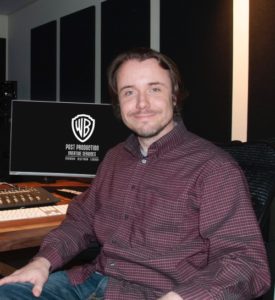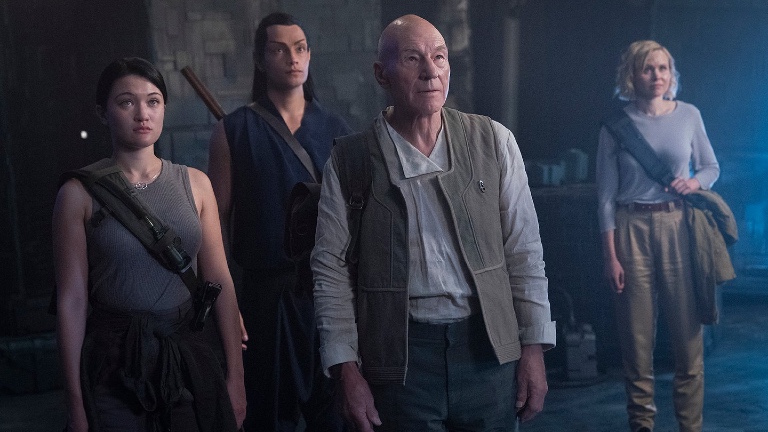The CBS All Access series Star Trek: Picard features the legendary Sir Patrick Stewart reprising his role as the beloved Jean-Luc Picard after the conclusion of Star Trek: The Next Generation and 20 years after his last appearance in Star Trek: Nemesis. The new series focuses on Picard’s next chapter in his life after the death of his dear friend Data with a calling and deep desire to help twin synthetic android sisters of Soji and Dahj, both played by Isa Briones.

Episode 10, titled “Et in Arcadia Ego, Part 2,” has been nominated for an Emmy award in sound, and it’s the culmination of the sound for the first season. (NOTE: There may be plot spoilers for Season 1 of Picard in this article.) Sound Supervisor Matthew E. Taylor explained, “We come back to our captain, but he’s obviously struggling with a lot of internal things. This is the episode that resolves all of that. There’s a whole finale of the episode where we have to create this world that Picard is in this limbo death state and he’s able to address everything that has been haunting him this whole season. What was really special about this episode from a sound point of view is building all these worlds up until that point and having this almost dead space scene where Picard can basically resolve everything, and we can send off Data in a way that hopefully the fans enjoy.”

Sound Editor Tim Farrell added, “Our biggest priority was trying to help the world really come alive and become its own environment; living, breathing space for our characters to live in, and to provide as much personality and character as we could to all the elements that the visual team created for us. Our biggest thought was to create that sense of wonder and nostalgia to the Star Trek universe for the fans who were returning to see their captain again.”
The space battle encompassed a variety of sounds from the scope of the battle, reproduction of the different ships, ship movements, ship impacts, phasers, blasters, torpedoes, and a planetary defense system that involves orchids. The sound editor detailed, “The orchids were an interesting challenge because they’re essentially a planetary defense mechanism, but they’re completely organic. We had to create that sense of balance between technology, mechanical, and this organic sense that they were alive and tough. We found some interesting synth sounds that had an organic, vocal quality to them that was used as a signature sound for the orchids. The tower that builds itself throughout the episode that would open up a portal was another challenge. For the sound of the alien tech coming through the portal, I used sea otters as the sound of the robots; then I ran it through distortion to help give it an almost fuzzy, digital quality to it.”
Foley was a major component in creating the surface sound for the Borg cube in episode 10. “The biggest issue was trying to figure out what that surface sounds like. It’s metal, but it’s not metal. It needs to be a resonant deep metal, as if it’s tied to everything else in the ship. When Picard meets Data in the Data escape, we hear Data walk up and sit down. It’s almost a hyper real scene. All we hear is the foley and the backgrounds going on, these upholster couches and hardwood floors were anchored in realism there,” Taylor revealed.

The Romulan language was thoroughly detailed and developed specially for the show. The sound supervisor accentuated, “The biggest challenge was the Romulan language. The language was actually canonized for the series. Lots of time was spent in figuring out how this language is going to be spoken, how it’s going to be performed, where the inflections are going to be, and how the language is affected culturally on Vashti; which is where many of the Romulan refugees are. There was much discussion about how to portray emotion through the Romulan language that these people hadn’t even spoken before.”
The mix process was a fine and dynamic balance between large bombastic sounds with subtle gentleness. “The idea is to fill in these scenes, especially during the attack; make it large and huge. But don’t wear the listener out to where we get to this moment, the resolution, and it’s viewed as a respite as opposed to a welcomed resolution. The balance was to go large when we need to go large; which is when the beacon is powering up, building the space battle, the orchids, the fleet arriving, Riker fighting, and then leading into the fourth act of Picard,” Taylor said.
“A lot of it has to do with the emotion of what we’re trying to sell. It was about trying to balance chaos with subtlety and quiet and trying to find those moments between peril and softness and gentleness. Just trying to create a sense of dynamics to the episodes, that we’re not constantly bombarded with sounds and also finding moments to step back and allow the wonderful performances and beautiful writing carry the scene. We don’t always need to have big bombastic sound effects to help people know what’s going on,” Farrell added.
The sound editor reflected, “We wanted to make the world exist and feel as it’s part of the Next Generation universe sonically. There’s definitely a lot of memory, opinion, and thought about what that world sounds like. The challenge of being 20 odd years later is creating something unique and new to this new story, but also have it feel a part of this other world that people know, expect, and are used to.”

When considering the sound editing for Star Trek: Picard, the sound approach is much more intimate than Star Trek: Discovery or other universes, as it is a personal journey for Picard. “Discovery is more of an action-oriented show. Whereas, this show is about intimacy and a personal journey as we go with Picard down his quest to find what remains of his lifelong friend that he misses dearly. That definitely has been the impetus of the show and with our sound. It’s really lovely to be able to work on shows that are in this similar universe, but have such different tones, qualities, and aesthetics,” Farrell expressed.
Sound Supervisor Matthew E. Taylor has been nominated 6 times for a Primetime Emmy with one win. Sound Editor Tim Farrell has nominated for a total of 8 times. Star Trek: Picard is nominated in both sound categories of Outstanding Sound Editing and Outstanding Sound Mixing for a Comedy or Drama Series (One Hour).
Primetime Emmy Nominations:
Outstanding Sound Editing for a Comedy or Drama Series (One Hour):
Matthew E. Taylor, Sound Supervisor
Tim Farrell, Sound Editor
Harry Cohen, Sound Editor
Michael Schapiro, Sound Editor
Sean Heissinger, Sound Editor
Clay Weber, Sound Editor
Moira Marquis, Music Editor
Stan Jones, Music Editor
Alyson Dee Moore, Foley Artist
Chris Moriana, Foley Artist
Outstanding Sound Mixing for a Comedy or Drama Series (One Hour):
Peter J. Devlin, Production Mixer
Todd Grace, Re-recording Mixer
Ed Carr, Re-recording Mixer
Michael Perfitt, Scoring Mixer





